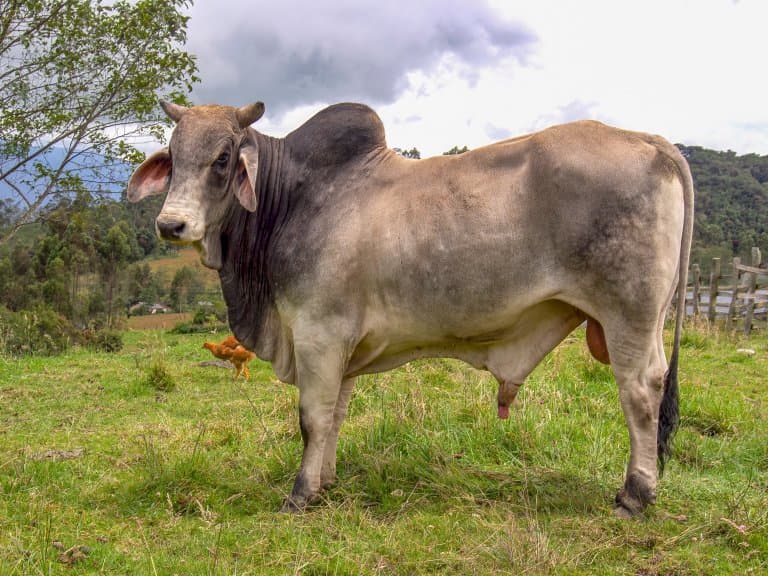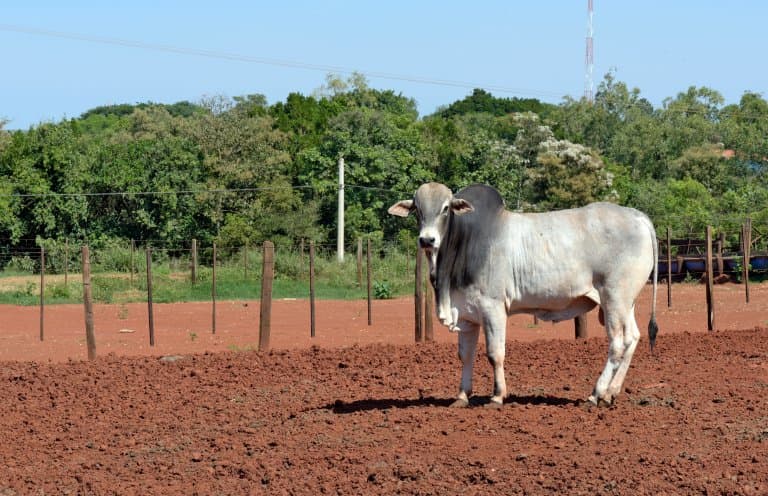Zebu Profile
Humped cattle come in two major groupings, defined by the position of the hump. Cows with a hump at the neck end are known as neck-humped cattle, the others are known as chest-humped.
While chest humps are obviously preferable to neck humps, this isn’t a taxonomic distinction, and there are some cows who come with either or both.
The Zebu comes in a neck-humped and chest-humped variety, depending on where they’re being bred, and this reflects an ongoing confusion around how to differentiate between the various species, subspecies and ancestral species of multiple groups of livestock.
Zebu are a species, or subspecies of domestic cattle native to South Asia. They are sometimes known as the ‘indicine cattle’, ‘camel cow’, or ‘humped cattle’.

Zebu Facts Overview
| Habitat: | Tropical, captive livestock |
| Location: | Africa and Asia |
| Lifespan: | 20+ years |
| Size: | Up to 1.4m (4.6 ft) tall |
| Weight: | Up to 445kg (981 lb) |
| Colour: | Varied: grey, black, red, white, spotted |
| Diet: | Grass, forbs |
| Predators: | Humans, jaguars, tigers, lions |
| Top Speed: | Unknown |
| No. of Species: | 1 |
| Conservation Status: | Not Listed (domestic) |
Zebu are a type of large cow and one of the most ancient domestic cattle breeds we know of.
Originating in India in the early days of civilisation, they’ve since spread out all over the world, dominating harsh environments over other livestock breeds on account of their resistance to drought, parasites and high temperatures.
Their taxonomy is still a matter of debate, with the African Sanga playing a role in their current morphology, but the relationship between the two is still a bit uncertain.
Regardless, they are now one of the most successful animals on the planet.
Interesting Zebu Facts
1. They’re likely their own species
As is the case with a lot of domestic animals, their taxonomy is a bit muddy. The Zebu looks distinct from the domestic cows you find in much of the US and Europe (Bos taurus), but whether or not it’s genetically different enough to call it a separate species has been a matter of debate.
For a while it was thought to be its own species, then it was described as a subspecies of B. taurus, and then everyone changed their minds again and it’s now considered a separate species, B. indicus, though still not by everyone.

2. There are over 75 ‘breeds’ of zebu
There are over 75 breeds of zebu evenly divided between African and Indian breeds.
Popular breeds include the American Brahman, Gyr cattle, Nelore, Guzerat, Indu-Brasil and Red Sindhi.
There are also hybrids, to make it more complicated. Some scientists believe the African Sanga cattle breeds might have originated from zebu hybrids.
3. They’re one of the oldest domesticated breeds of cattle
Regardless of what it actually is, the Zebu is certainly an ancient breed. Cows were domesticated as far back as 11,000 years ago, most, if not all of which, from the Aurochs, Bos taurus primigenius.
Zebu appear to have derived from one of the Indian forms of these amazing bovids called the Indian aurochs, around 7,000 years ago, probably in Pakistan.
Its wild ancestor has since gone extinct, likely around 3,800 years ago, having been more or less replaced by their domestic progeny. What’s left would have been bred by people connected with some of the earliest forms of fixed civilization, around Mesopotamia, and the practice subsequently became widespread across Asia. 1
4. They’re multi-purpose cattle
Zebu production must have been a revolution to early civilisations on the continent. Traditionally they would have rapidly expanded the efficiency of tilling; pulling heavy ploughs to prepare land for planting.
This alone would have been responsible for some of the earliest population explosions of the agricultural era. But this hardy animal brought with it a wealth of other resources, too.
Pastoralists could now feed on the milk their plough animals produced, as well as curds made from the fermented milk.
Meat and hide would have been rich sources of protein and textiles, respectively, and the zebu even offered cultural enrichment, with festivals celebrating good harvests and the ancient sport of zebu wrestling, something which is still practised in Madagascar. 2

5. They’re heat-adapted
While zebu aren’t as fertile and don’t produce as much milk as some of the more modern B. taurus equivalents, their strength lies in their toughness. Zebu are heat tolerant, need far less water and have inherent parasite resistance.
As a whole, they’re exceptionally hardy animals, well adapted to harsh environments, and therefore do better than any other breed in this context.
The sleek, dense coat of the zebu reflects heat away from the animal, reducing increases in body temperature in hot weather.
They’re also great at sweating, which is something many of us take for granted, but not universal among mammals. These adaptations have led to their widespread popularity all over the world. 3
6. They’ve been very successful as livestock
The fact that this resilient cow breed made it to Madagascar indicates how popular it was as livestock.
Zebu spread out of India, and across Africa and was also introduced to South America. In Brazil, they have become the dominant cattle breed and even the US now has over 2 million of them.
Zebu are highly adaptable and tough animals, capable of thriving in a range of habitats and environments. As they’ve spread, they’ve developed different looks, one of the most notable is the positions of their humps. 4

7. They have humps
Unlike the camel, the humps in cows like this are not made up primarily of fatty tissue, instead, they’re either mostly muscle or a mix of muscle and fat.
It’s thought the name Zebu descends from a Tibetan word meaning hump, but this would likely have referred to the chest hump, as the neck-humped zebu appears to show up primarily in Africa.
The chest-humped zebu is found all over Asia and as an introduced breed in East Africa, where it has interbred with the neck-humped Sanga to form a hybrid of the two.
The role of these humps isn’t fully understood but neck humps are commonly found on animals with heavy heads and large horns, as a counter-balance to the downward pull of their front ends. So, the neck humps are generally muscle, while the chest humps are a sort of mix of muscle and fat. 5
8. There are mini zebus
For reasons unknown, there are tiny varieties of this species, known as miniature zebus. At around a meter tall, and about half the weight of the large breed, these petite cows have a hump on their shoulders and are said to be very rare.
Discovered in Southern India, their local name essentially means “small cow”, and they can be more or less used for all the same things the larger version is, but on a smaller scale.
They’ve been popular in zoos on account of their inherent toughness and cute little stature, and have been imported to captive settings in Australia, the US and New Zealand.
Zebu Fact-File Summary
Scientific Classification
| Kingdom: | Animalia |
| Phylum: | Chordata |
| Class: | Mammalia |
| Order: | Artiodactyla |
| Family: | Bovidae |
| Subfamily: | Bovinae |
| Genus: | Bos |
| Species: | Bos Taurus |
| Subspecies: | Bos Taurus Indicus |
Fact Sources & References
- (2022), “Zebu”, The Cattle Site.
- Spooky (2011), “Savika – Wrestling Angry Bulls in Madagascar”, Oddity Central.
- “Zebu”, Science Direct.
- (2023), “Geographical distribution of zebu breeds and their relationship with environmental variables and the human development index”, Scielo Brazil.
- H. Epstein (2015), “The Zebu Cattle of East Africa”, Taylor & Francis Online.
